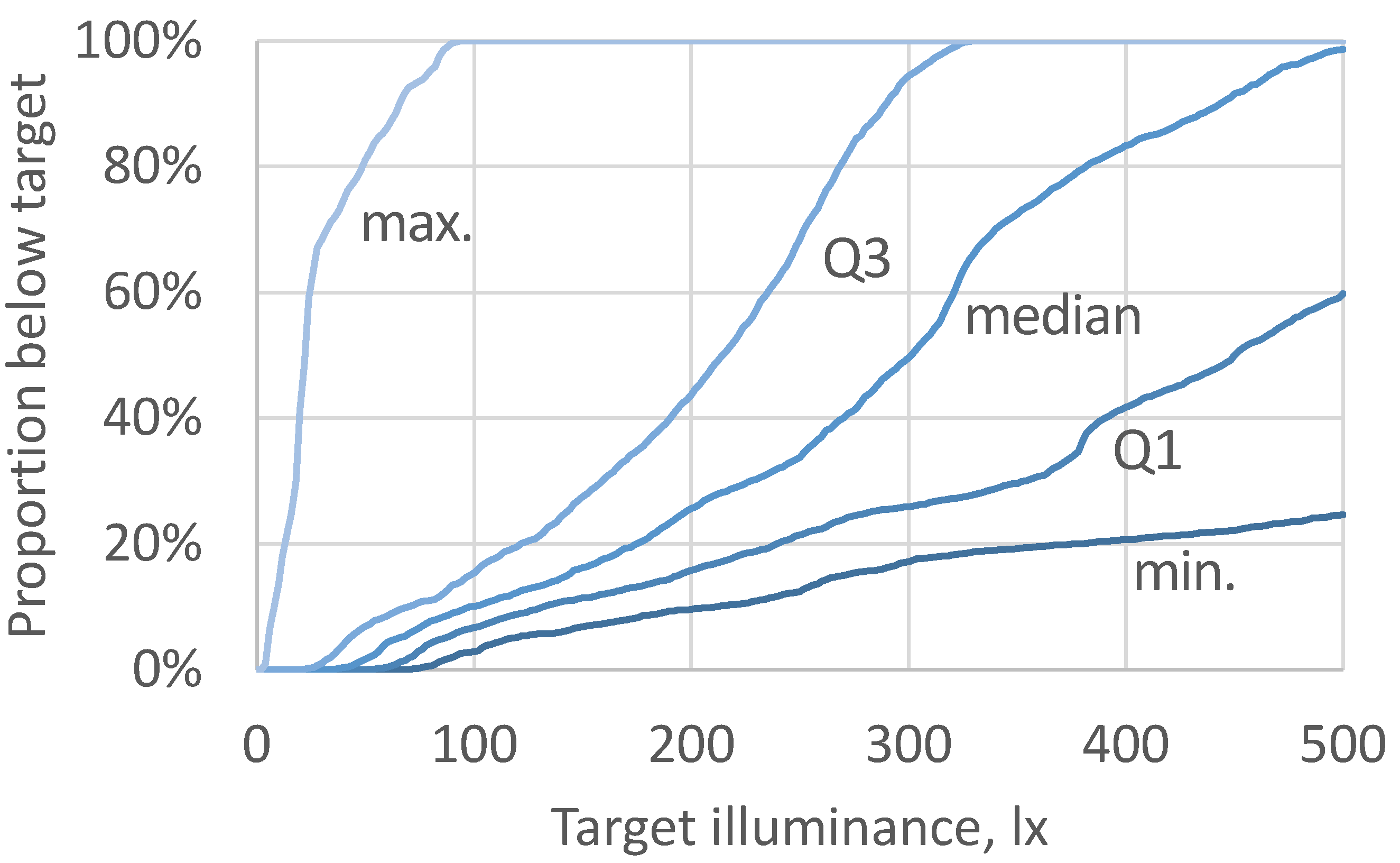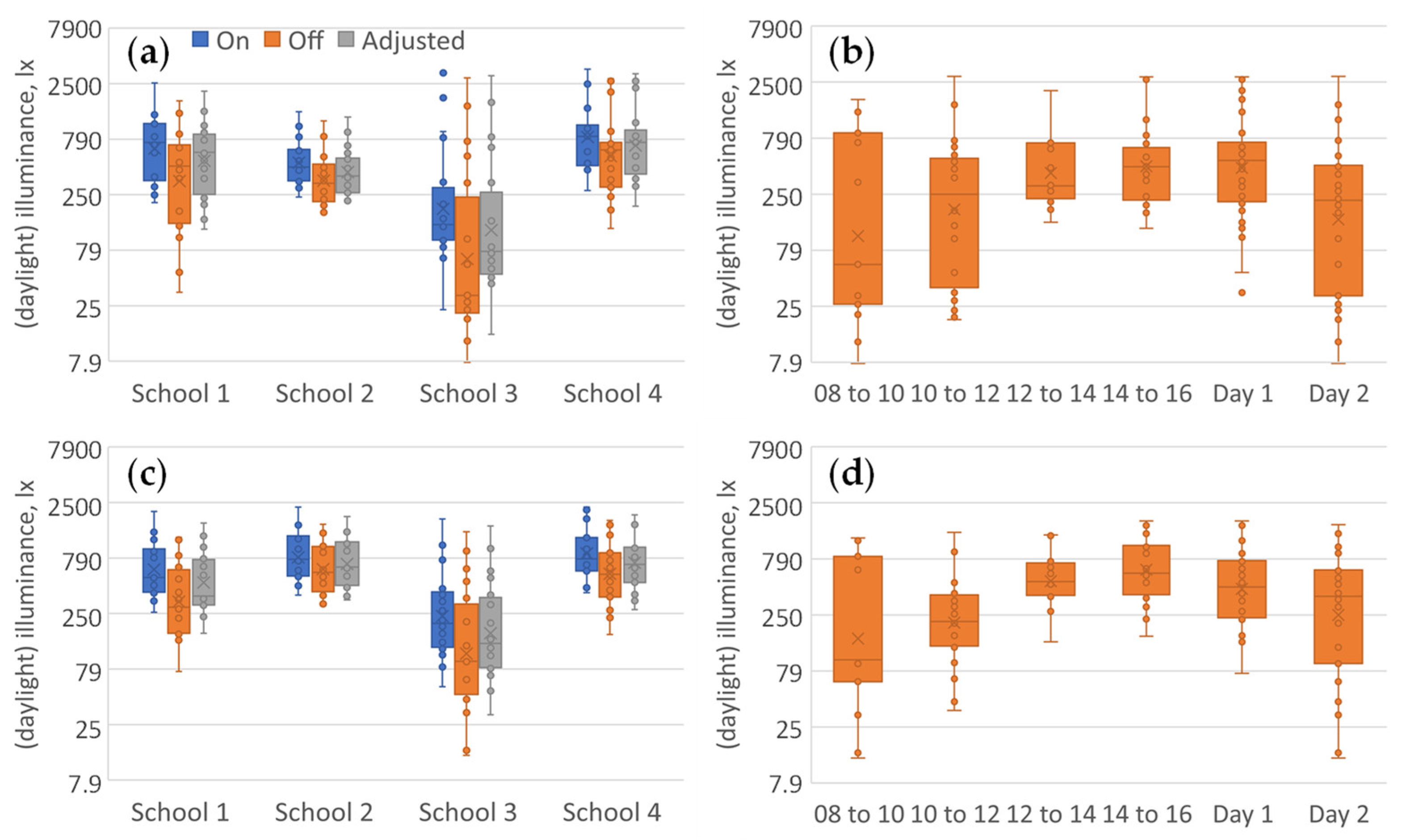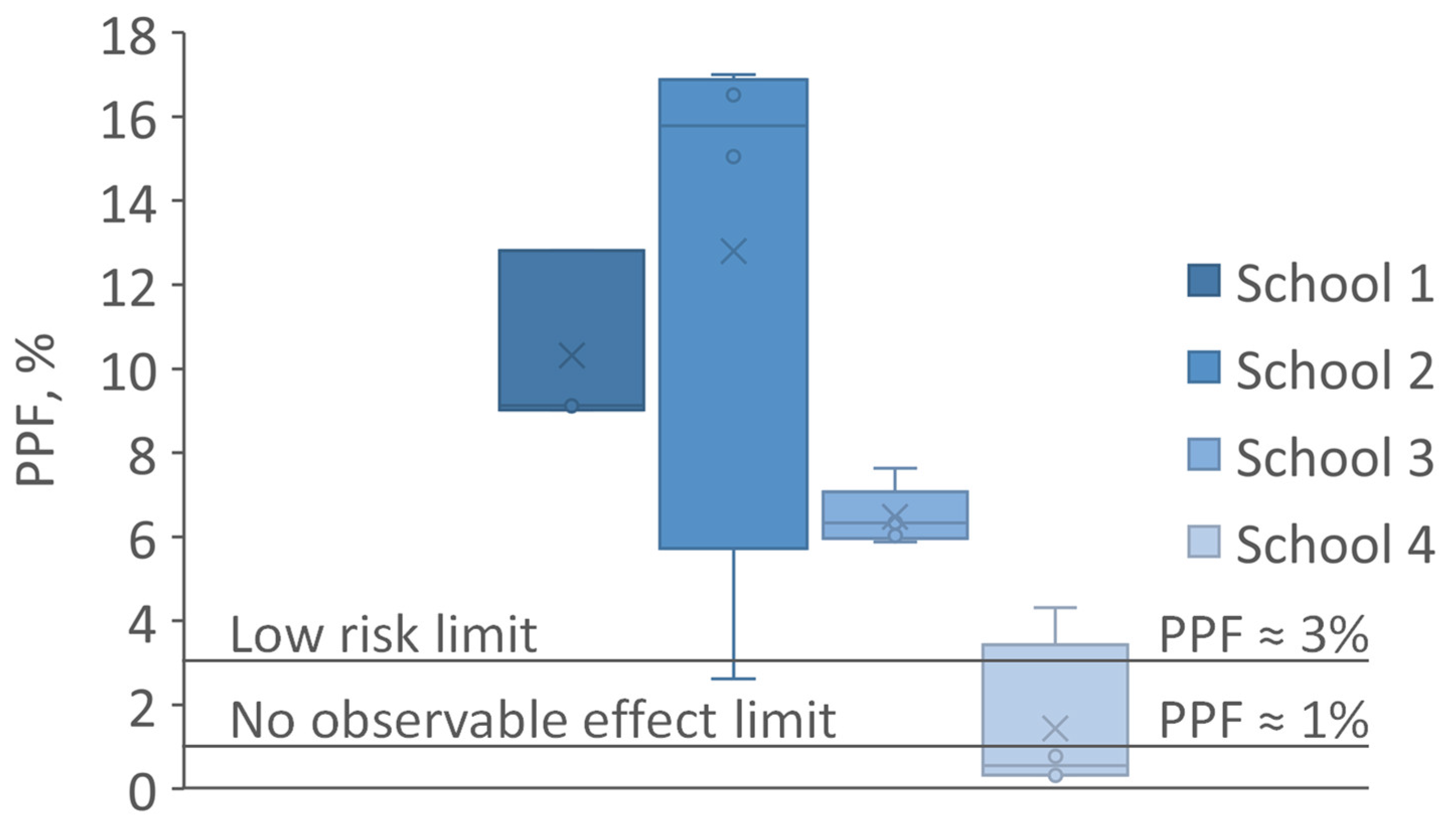Daylight and Electric Lighting in Primary and Secondary School Classrooms in the UK—An Observational Study
Abstract
:1. Introduction
1.1. Assessing Lighting Quality
1.2. Objectives
- To monitor vertical daylight illuminance entering the classroom and arriving at the back of the classroom during school hours, to assess daylight penetration and daylight autonomy against vertical illuminance targets;
- To collect vertical grid eye height illuminance—snapshots during school hours, supported by monitoring data, with lights on and off—as descriptive data at potential exposure positions;
- To collect spectral distribution data for electric lighting to determine the Correlated Colour Temperature (CCT) and melanopic Daylight Efficacy Ratio (m-DER) [28], as measures describing the non-visual stimulus for a given illuminance;
2. Materials and Methods
2.1. Measurements
2.2. Assessments

3. Results
4. Discussion
5. Conclusions
Author Contributions
Funding
Institutional Review Board Statement
Informed Consent Statement
Data Availability Statement
Acknowledgments
Conflicts of Interest
References
- Mullan, K. A Child’s Day: Trends in Time Use in the UK from 1975 to 2015. Br. J. Sociol. 2019, 70, 997–1024. [Google Scholar] [CrossRef] [PubMed]
- Deng, L.; Pang, Y. Effect of Outdoor Activities in Myopia Control: Meta-Analysis of Clinical Studies. Optom. Vis. Sci. 2019, 96, 276–282. [Google Scholar] [CrossRef] [PubMed]
- Li, D.; Min, S.; Li, X. Are Spending More Time Outdoors Able to Prevent and Control Myopia in Children and Adolescents? A Meta-Analysis. Ophthalmic Res. 2024, 1–12. [Google Scholar] [CrossRef]
- Morgan, I.G.; French, A.N.; Ashby, R.S.; Guo, X.; Ding, X.; He, M.; Rose, K.A. The Epidemics of Myopia: Aetiology and Prevention. Prog. Retin Eye Res. 2018, 62, 134–149. [Google Scholar] [CrossRef] [PubMed]
- He, X.; Sankaridurg, P.; Wang, J.; Chen, J.; Naduvilath, T.; He, M.; Zhu, Z.; Li, W.; Morgan, I.G.; Xiong, S.; et al. Time Outdoors in Reducing Myopia: A School-Based Cluster Randomized Trial with Objective Monitoring of Outdoor Time and Light Intensity. Ophthalmology 2022, 129, 1245–1254. [Google Scholar] [CrossRef] [PubMed]
- Jiang, D.; Lin, H.; Li, C.; Liu, L.; Xiao, H.; Lin, Y.; Huang, X.; Chen, Y. Longitudinal Association between Myopia and Parental Myopia and Outdoor Time among Students in Wenzhou: A 2.5-Year Longitudinal Cohort Study. BMC Ophthalmol. 2021, 21, 11. [Google Scholar] [CrossRef] [PubMed]
- Read, S.A.; Collins, M.J.; Vincent, S.J. Light Exposure and Eye Growth in Childhood. Investig. Ophthalmol. Vis. Sci. 2015, 56, 6779–6787. [Google Scholar] [CrossRef] [PubMed]
- Wu, P.C.; Chen, C.T.; Lin, K.K.; Sun, C.C.; Kuo, C.N.; Huang, H.M.; Poon, Y.C.; Yang, M.L.; Chen, C.Y.; Huang, J.C.; et al. Myopia Prevention and Outdoor Light Intensity in a School-Based Cluster Randomized Trial. Ophthalmology 2018, 125, 1239–1250. [Google Scholar] [CrossRef] [PubMed]
- McCullough, S.J.; O‘Donoghue, L.; Saunders, K.J. Six Year Refractive Change among White Children and Young Adults: Evidence for Significant Increase in Myopia among White UK Children. PLoS ONE 2016, 11, e0146332. [Google Scholar] [CrossRef] [PubMed]
- Shah, R.; Edgar, D.F.; Evans, B.J.W. Worsening Vision at Age 4–5 in England Post-COVID: Evidence from a Large Database of Vision Screening Data. Ophthalmic Physiol. Opt. 2023, 43, 454–465. [Google Scholar] [CrossRef]
- Rudnicka, A.R.; Owen, C.G.; Nightingale, C.M.; Cook, D.G.; Whincup, P.H. Ethnic Differences in the Prevalence of Myopia and Ocular Biometry in 10- and 11-Year-Old Children: The Child Heart and Health Study in England (CHASE). Investig. Ophthalmol. Vis. Sci. 2010, 51, 6270–6276. [Google Scholar] [CrossRef] [PubMed]
- Williams, K.M.; Verhoeven, V.J.; Cumberland, P.; Bertelsen, G.; Wolfram, C.; Buitendijk, G.H.; Hofman, A.; van Duijn, C.M.; Vingerling, J.R.; Kuijpers, R.W.; et al. Prevalence of Refractive Error in Europe: The European Eye Epidemiology (E(3)) Consortium. Eur. J. Epidemiol. 2015, 30, 305–315. [Google Scholar] [CrossRef] [PubMed]
- Holden, B.A.; Jong, M.; Davis, S.; Wilson, D.; Fricke, T.; Resnikoff, S. Nearly 1 Billion Myopes at Risk of Myopia-Related Sight-Threatening Conditions by 2050—Time to Act Now. Clin. Exp. Optom. 2015, 98, 491–493. [Google Scholar] [CrossRef] [PubMed]
- Bullimore, M.A.; Brennan, N.A. Myopia Control: Why Each Diopter Matters. Optom. Vis. Sci. 2019, 96, 463–465. [Google Scholar] [CrossRef]
- Pezzullo, L.; Streatfeild, J.; Simkiss, P.; Shickle, D. The Economic Impact of Sight Loss and Blindness in the UK Adult Population. BMC Health Serv. Res. 2018, 18, 63. [Google Scholar] [CrossRef] [PubMed]
- Wildsoet, C.F.; Chia, A.; Cho, P.; Guggenheim, J.A.; Polling, J.R.; Read, S.; Sankaridurg, P.; Saw, S.M.; Trier, K.; Walline, J.J.; et al. IMI—Interventions for Controlling Myopia Onset and Progression Report. Investig. Ophthalmol. Vis. Sci. 2019, 60, M106–M131. [Google Scholar] [CrossRef]
- World Health Organization (WHO). The Impact of Myopia and High Myopia; Report of the Joint World Health Organization–Brien Holden Vision Institute Global Scientific Meeting on Myopia; University of New South Wales: Sydney, Australia, 2015. [Google Scholar]
- Bernardi, M.; Fish, L.; van de Grint-Stoop, J.; Knibbs, S.; Goodman, A.; Calderwood, L.; Mathers, S.; Deepchand, K.; Ferguson, C.; Borges, T.; et al. Children of the 2020s: First Survey of Families at Age 9 Months. 2023. Available online: https://eprints.bbk.ac.uk/id/eprint/52588/1/52588.pdf, (accessed on 25 June 2024).
- Brembilla, E.; Mardaljevic, J. Climate-Based Daylight Modelling for Compliance Verification: Benchmarking Multiple State-of-the-Art Methods. Build. Environ. 2019, 158, 151–164. [Google Scholar] [CrossRef]
- Brown, T.M.; Brainard, G.C.; Cajochen, C.; Czeisler, C.A.; Hanifin, J.P.; Lockley, S.W.; Lucas, R.J.; Munch, M.; O‘Hagan, J.B.; Peirson, S.N.; et al. Recommendations for Daytime, Evening, and Nighttime Indoor Light Exposure to Best Support Physiology, Sleep, and Wakefulness in Healthy Adults. PLoS Biol. 2022, 20, e3001571. [Google Scholar] [CrossRef] [PubMed]
- CIE S 017/E:2020; ILV: International Lighting Vocabulary. CIE: Vienna, Austria, 2020.
- CIE TN 006:2016; Visual Aspects of Time-Modulated Lighting Systems—Definitions and Measurement Models. CIE: Vienna, Austria, 2016.
- CIE TN 008:2017; Final Report CIE Stakeholder Workshop for Temporal Light Modulation Standards for Lighting Systems. CIE: Vienna, Austria, 2017.
- Price, L.L.A. Can the Adverse Health Effects of Flicker from LEDs and Other Artificial Lighting Be Prevented? LEUKOS 2017, 13, 191–200. [Google Scholar] [CrossRef]
- IEEE SA-P1789; Recommended Practices for Modulating Current in High-Brightness LEDs for Mitigating Health Risks to Viewers. IEEE: New York, NY, USA, 2015.
- Miller, N.J.; Bermudez, E.R.-F.; Irvin, L.; Tan, J. Phantom Array and Stroboscopic Effect Visibility under Combinations of TLM Parameters. Light. Res. Technol. 2023. [Google Scholar] [CrossRef]
- Price, L.L.A.; Khazova, M.; O‘Hagan, J.B. Human Responses to Lighting Based on Led Lighting Solutions—Commissioned by the Chartered Institution of Building Services Engineers and the Society of Light and Lighting; Public Health England: London, UK, 2016. [Google Scholar]
- Schlangen, L.J.M.; Price, L.L.A. The Lighting Environment, Its Metrology, and Non-Visual Responses. Front. Neurol. 2021, 12, 624861. [Google Scholar] [CrossRef] [PubMed]
- Price, L.L.A.; Lyachev, A. Modification of a Personal Dosimetry Device for Logging Melanopic Irradiance. Light. Res. Technol. 2017, 49, 922–927. [Google Scholar] [CrossRef]
- BS EN 1729-1:2006; Furniture. Chairs and Tables for Educational Institutions—Functional Dimensions. British Standards Institution (BSI): London, UK, 2006; withdrawn 2015.
- Fredriks, A.M.; van Buuren, S.; van Heel, W.J.; Dijkman-Neerincx, R.H.; Verloove-Vanhorick, S.P.; Wit, J.M. Nationwide Age References for Sitting Height, Leg Length, and Sitting Height/Height Ratio, and Their Diagnostic Value for Disproportionate Growth Disorders. Arch. Dis. Child. 2005, 90, 807–812. [Google Scholar] [CrossRef] [PubMed]
- Wright, C.M.; Williams, A.F.; Elliman, D.; Bedford, H.; Birks, E.; Butler, G.; Sachs, M.; Moy, R.J.; Cole, T.J. Using the New UK-Who Growth Charts. BMJ-Br. Med. J. 2010, 340. [Google Scholar] [CrossRef] [PubMed]
- Dahlmann-Noor, A.H.; Khazova, M.; Bokre, D.; Price, L.L.A. Measuring the Visual Environment of Children and Young People at Risk of Myopia: A Scoping Review—Initial Findings. In Proceedings of the 30th Session of the CIE, Ljubljana, Slovenia, 15–23 September 2023; International Commission on Illumination (CIE): Vienna, Austria, 2023; pp. 1137–1153. [Google Scholar]
- de Groot, S.; Brembilla, E.; Dahlmann-Noor, A.H.; Price, L.L.A.; Khazova, M.; Eijkelenboom, A.; Turrin, M. A Simulation-Based Method to Quantify Daylight Exposure and Its Effect on the Onset of Myopia in Primary School Children. In Proceedings of the 30th Session of the CIE, Ljubljana, Slovenia, 15–23 September 2023; International Commission on Illumination (CIE): Vienna, Austria, 2023; pp. 1259–1266. [Google Scholar]
- Alfonsin, N.; McLeod, V.; Loder, A.; DiPietro, L. Active Design Strategies and the Evolution of the Well Building Standard. J. Phys. Act Health 2018, 15, 885–887. [Google Scholar] [CrossRef] [PubMed]
- Veitch, J.A.; McColl, S.L. Modulation of Fluorescent Light: Flicker Rate and Light Source Effects on Visual Performance and Visual Comfort. Int. J. Light. Res. Technol. 1995, 27, 243–256. [Google Scholar] [CrossRef]
- Wilkins, A.J.; Nimmo-Smith, I.; Slater, A.I.; Bedocs, L. Fluorescent Lighting, Headaches and Eyestrain. Light. Res. Technol. 1989, 21, 11–18. [Google Scholar] [CrossRef]
- Tan, J.; Miller, N.; Royer, M.; Irvin, L. Temporal Light Modulation: A Phantom Array Visibility Measure. Light. Res. Technol. 2024. [Google Scholar] [CrossRef]
- Government of the United Kingdom. The Ecodesign for Energy-Related Products and Energy Information (Lighting Products) Regulations 2021 (S.I. 2021/1095); Stationary Office: London, UK, 2021.
- Perz, M. Opinion: Setting the Stroboscopic Visibility Threshold. Light. Res. Technol. 2020, 52, 322. [Google Scholar] [CrossRef]




Disclaimer/Publisher’s Note: The statements, opinions and data contained in all publications are solely those of the individual author(s) and contributor(s) and not of MDPI and/or the editor(s). MDPI and/or the editor(s) disclaim responsibility for any injury to people or property resulting from any ideas, methods, instructions or products referred to in the content. |
© 2024 by the authors. Licensee MDPI, Basel, Switzerland. This article is an open access article distributed under the terms and conditions of the Creative Commons Attribution (CC BY) license (https://creativecommons.org/licenses/by/4.0/).
Share and Cite
Price, L.L.A.; Dahlmann-Noor, A.; Khazova, M. Daylight and Electric Lighting in Primary and Secondary School Classrooms in the UK—An Observational Study. Int. J. Environ. Res. Public Health 2024, 21, 942. https://doi.org/10.3390/ijerph21070942
Price LLA, Dahlmann-Noor A, Khazova M. Daylight and Electric Lighting in Primary and Secondary School Classrooms in the UK—An Observational Study. International Journal of Environmental Research and Public Health. 2024; 21(7):942. https://doi.org/10.3390/ijerph21070942
Chicago/Turabian StylePrice, Luke L. A., Annegret Dahlmann-Noor, and Marina Khazova. 2024. "Daylight and Electric Lighting in Primary and Secondary School Classrooms in the UK—An Observational Study" International Journal of Environmental Research and Public Health 21, no. 7: 942. https://doi.org/10.3390/ijerph21070942
APA StylePrice, L. L. A., Dahlmann-Noor, A., & Khazova, M. (2024). Daylight and Electric Lighting in Primary and Secondary School Classrooms in the UK—An Observational Study. International Journal of Environmental Research and Public Health, 21(7), 942. https://doi.org/10.3390/ijerph21070942






